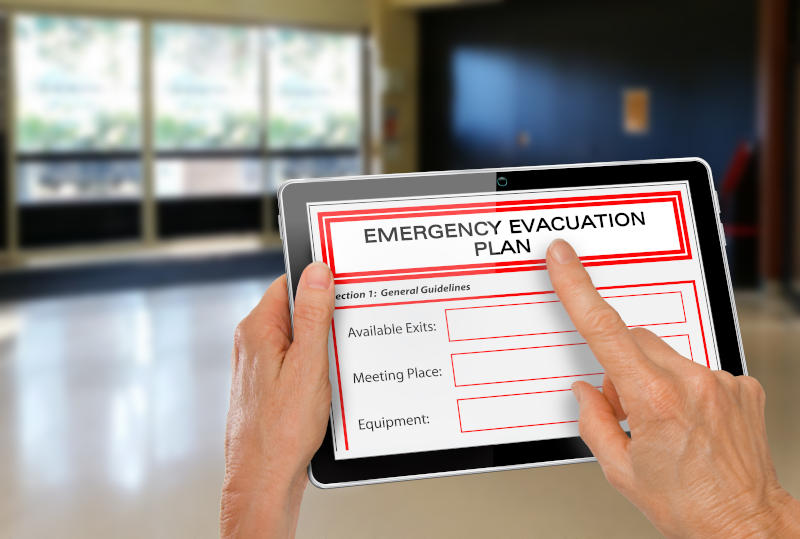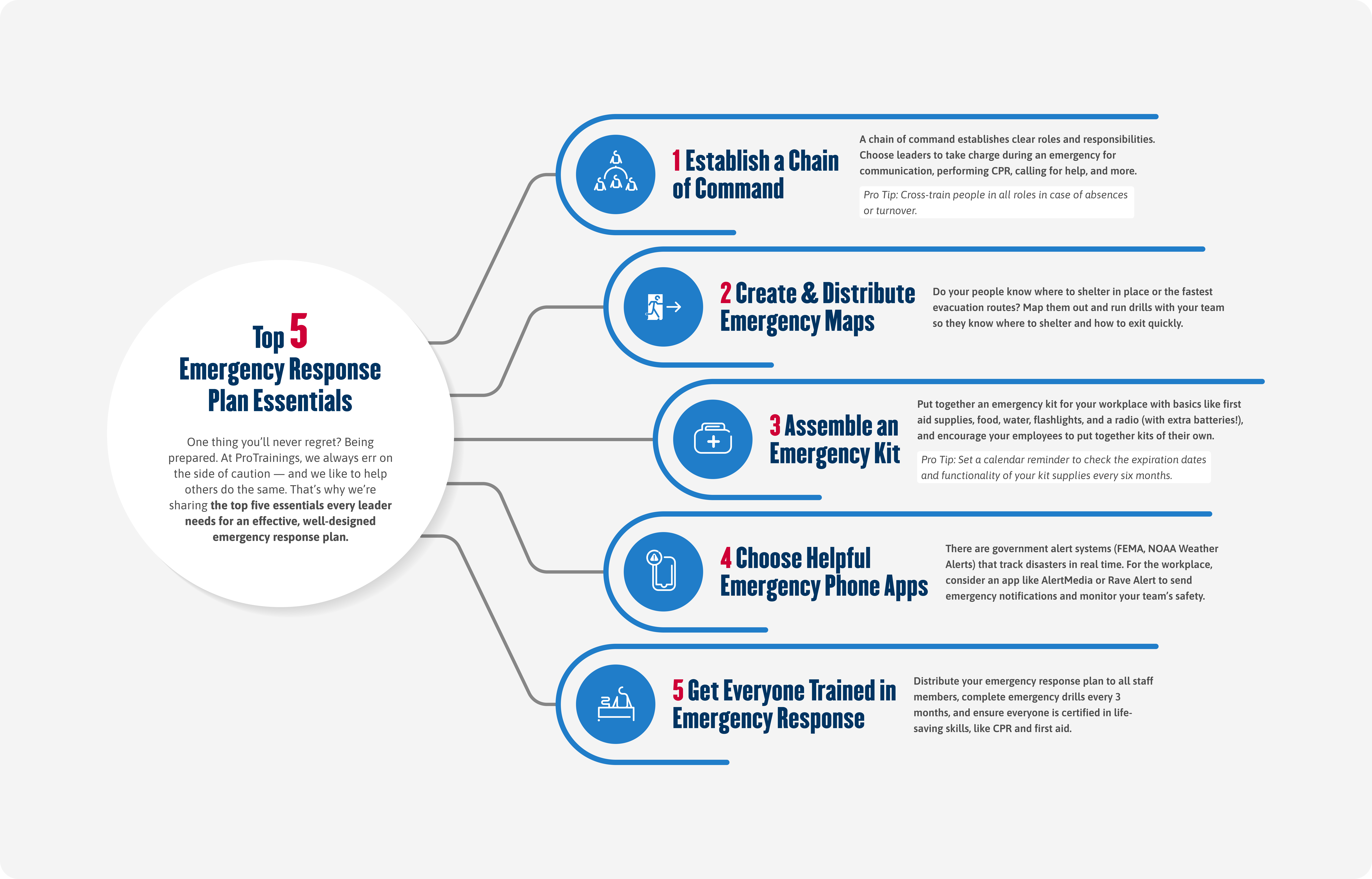Table of Contents
- What Is an Emergency Response Plan?
- What Should Be Included in Your Emergency Response Plan?
- How Do You Implement Your Plan?
- Need More Help Planning for Emergencies?
When disaster strikes, every second matters. If staff members are unsure of how to handle an emergency — be it a medical crisis, a natural disaster, a workplace accident, or something else — a bad situation can quickly become worse. That’s when an emergency response plan (ERP) comes into play.
When you have a plan for how to handle emergencies in the workplace, you can avoid mass panic and confusion, keep your staff and others in the building safe from further harm, and get help from rescue workers more easily and quickly.
An effective emergency plan should be clear, easy to follow, and well-communicated to all staff members. While it takes time and resources to put such a plan together, it’s well worth the lives that could be saved because you’ve made preparations in advance.
Read on to learn more about how to create and implement an effective emergency response plan.
What Is an Emergency Response Plan?
Essentially, an emergency response plan is a set of standard operating procedures (SOPs) that tell people what to do in emergency situations. Creating this plan ahead of time helps prevent panic and disorder, facilitates quick and efficient rescues, and ultimately saves lives.
Examples of workplace emergencies to address include but are not limited to:
- Natural disasters such as tornadoes, floods, hurricanes, etc.
- Fires, explosions, chemical spills, and gas leaks
- Physical violence
- Sudden medical emergencies such as cardiac arrest
- Facility and operational accidents or emergencies
The first step to creating an emergency response plan is to identify the types of emergencies that could occur at your workplace. Then you’ll create a detailed plan for how to minimize risk and get help in each of those potential scenarios.
At ProTrainings, we’ve created a library of informative videos for all types of emergencies. Check out our video on what to do in the event of a cold-related emergency, like hypothermia.
What Should Be Included in Your Emergency Response Plan?
When creating your emergency response plan, start by brainstorming worst-case scenarios. For each type of emergency you identify, ask yourself what the impact of that emergency would look like.
Deciding on Your ERP Risk Factors
Based on the location and specifics of your organization, consider the following:
- What types of natural disasters and severe weather events is your location vulnerable to? Understanding the potential hazards in your area, whether they are earthquakes, landslides, floods, heat waves, or something else, is crucial for effective emergency planning. Address your region’s specific threats, and create a plan that ensures your team can respond swiftly and effectively when severe weather strikes.
- What potential facility or operational emergencies could put your team at risk? Each organization should anticipate emergencies specific to its operations. For instance, in historic buildings, vigilance against fire hazards such as outdated wiring is paramount. Banking institutions must take extra precautions against robberies. Identifying your unique risks ensures your emergency response plan will be practical and helpful during an extreme situation.
Weather and facility emergencies aside, some crises impact all organizations. Your place of work should have emergency response plans for all emergencies it can reasonably expect, including medical emergencies.
Additionally, consider that many emergencies often cause other emergencies, such as injuries, cardiac arrest, and shock. Learn how to combat this complex situation by watching our Shock Emergencies and Treatment video.
After determining what poses a risk to your team, facility, and operation, it’s time to build out the steps for what to do when facing the worst-case scenario. To help you put together a thorough plan that you can distribute to your team, download our free Emergency Response Plan guide by clicking the button below.
Determining Your ERP Steps
Planning your response requires several steps. Be sure to consider:
- Evacuation & shelter. Determine where and when people will need to evacuate in case of an emergency. Keep in mind some emergencies call for complete building evacuation, while others require people to shelter in place. Map out escape routes, and determine how long an evacuation is likely to take.
- Supplies. Make a list of supplies or survival equipment that you would need to handle each emergency situation. Then put together an emergency kit with those supplies, store it somewhere accessible, and regularly check the expiration date of the supplies.
- Backup plans. Brainstorm situations that could prevent people from following your plan, and set guidelines for what to do next. For example, have an alternative evacuation route in mind in case the best route becomes blocked unexpectedly.
- Training. Inform your staff of the emergency procedures, and train several reliable team members to take the lead and guide others in following the emergency response plan in case of an emergency. We cover this in depth in our Roles & Responsibilities section below.
- Post-emergency procedures. Once the dust settles and you’re out of crisis mode, what will you and your team need to continue with business as usual? Consider normal needs like completing damage assessment for insurance purposes and debriefing your emergency plan’s successes and areas of improvement.
Even with each of the factors considered and accounted for in your emergency response plan, no plan would be complete without a clear chain of command. People need to know who is responsible for decision-making and, equally as crucial, communication.
Developing Your ERP Communication
Establishing clear channels for disseminating information will bring much-needed structure in the event of an emergency. Compile lists of people to notify when a given emergency occurs, including staff, rescue personnel, and any visitors who may be present in the building.
Remember: When people are under pressure, easy-to-follow instructions can save lives.
Effective internal communication is crucial for your emergency response plan. After compiling comprehensive communication lists, appoint designated staff for communication during emergencies. Then implement emergency notification systems to communicate action steps. If you’ve done all of that, your communication is sure to stand a solid stress test.
The clearer and more detailed your plan is, especially regarding communication, the better prepared you’ll be to handle just about any emergency.
How Do You Implement Your Plan?
After you create your emergency response plan, the final step is to implement it. That means communicating expectations and instructions to the right people and helping ensure they’ll be able to follow those instructions in an emergency.

You can begin by posting escape route maps publicly throughout the facility, along with basic emergency response guidelines and phone numbers to call for help. Train a core team of willing and able staff members to take charge in the event of an emergency, and be sure to instruct other employees to follow their lead.
Roles & Responsibilities
Now that you’ve got a plan, it’s time to assign roles and responsibilities. Ask yourself and other key leaders the following questions:
- Who are the individuals we’ve identified for key leadership roles during emergencies, such as safety officers and communication coordinators?
- Have we cross-trained staff members to perform critical functions in case primary personnel are unavailable?
- When will we schedule regular reviews of roles and responsibilities to accommodate changes in personnel or organizational structure?
Clear roles and responsibilities are essential for effective emergency response. Every member of your team plays a crucial part in ensuring the safety and well-being of others.
Leveraging Technology
In the world of emergency preparedness, technology is your ultimate sidekick. In a few clicks, you can send out text alerts, emails, and automated phone calls, keeping everyone in the loop. You can build accessible databases of emergency contacts and resources and securely store them in the cloud.
Geographic information systems (GIS) can map out evacuation routes and pinpoint emergency shelters.
Another useful piece of tech in emergencies? Geographic information systems. Using GIS is like having a virtual tour guide for safety, guiding you through crisis management with ease. With technology by your side, you’ll be ready to help protect your team when an emergency arises.
Emergency Versus Non-Emergency Responsibilities
When the unexpected strikes, having clear priorities will keep things running smoothly. Your emergency response playbook should lay out which tasks take top priority during emergencies and which ones can wait for calmer times.
Clarity, strategy, and thinking ahead are your best allies in an emergency. With a solid plan in place and everyone on board, you’ll be well-equipped to navigate the twists and turns of emergency versus non-emergency responsibilities with confidence and ease.
Finally, it’s a good idea to not only practice emergency drills but also regularly evaluate and update your plan to account for any changes in the facility layout, workforce, or daily operations that could impact the effectiveness of your emergency response.
Be sure you’ve planned for the top five essentials of a successful emergency response plan. Download our free infographic here.

Need More Help Planning for Emergencies?
Having an effective emergency response plan will help ensure you and your staff are prepared to act quickly and safely in the event of an emergency. Like any other kind of SOP, the more clearly you define and communicate your plan, the easier it will be for people to follow when the need arises.
For more information, examples, and a guide to help you create your emergency response plan, download our white paper.
